How to Grow and Care for Strawberry Shake Philodendron
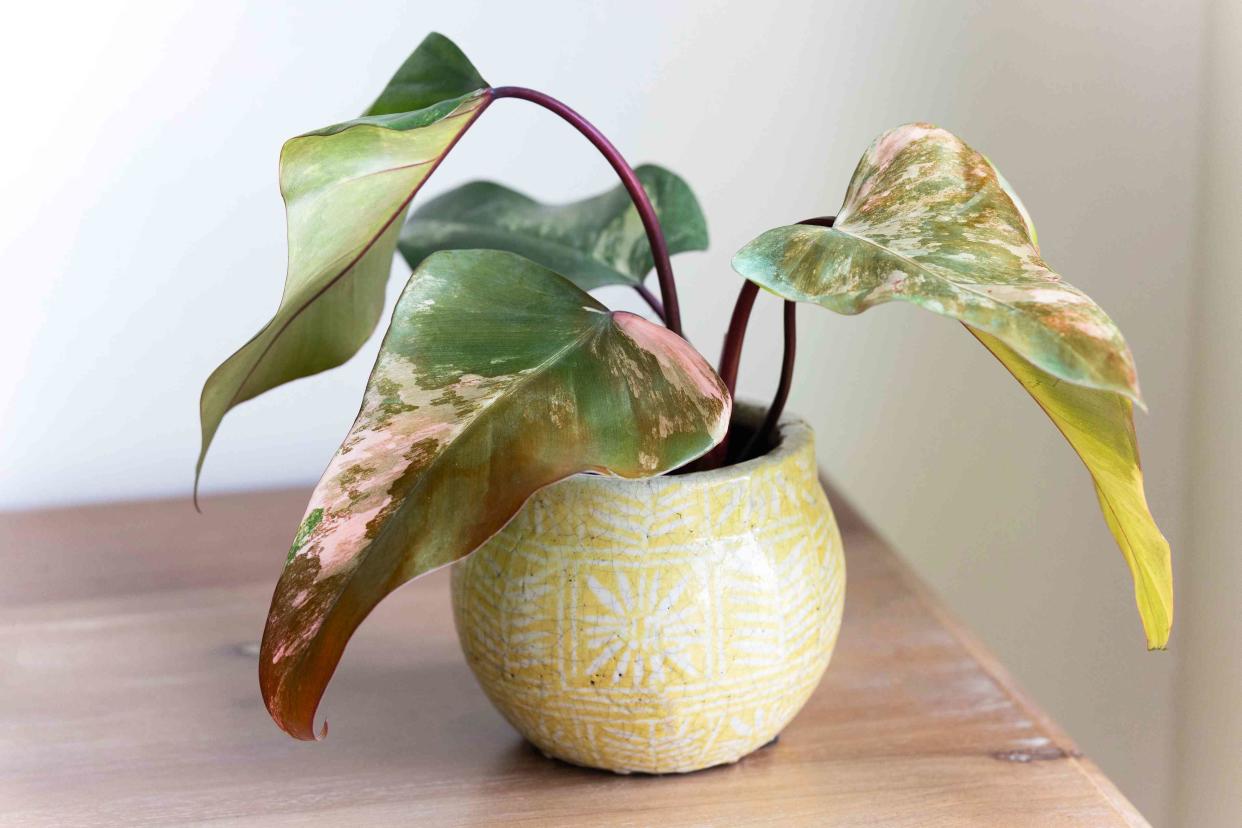
The Spruce / Adelyn Duchala
The strawberry shake philodendron (Philodendron erubescens ‘Strawberry Shake’) is a stunning variegated houseplant that is known for its unique pink, yellow, and cream coloring. Native to the rainforests of South America, this naturally occurring P. erubescens hybrid is known for being extremely rare and expensive to acquire. It’s particularly popular among houseplant collectors and enthusiasts but is gradually becoming more mainstream as people’s interest in variegated houseplants increases.
As with most variegated tropical plants, the strawberry shake philodendron needs some specific care requirements in order to grow well indoors. Pet owners and parents should also be aware that like all philodendrons, the strawberry shake is considered toxic to pets and kids if ingested. Here’s everything you need to know about how to grow and care for the strawberry shake philodendron indoors.
Common Name | Strawberry shake philodendron |
Botanical Name | Philodendron erubescens ‘Strawberry Shake’ |
Family | Araceae |
Plant Type | Perennial |
Mature Size | 3 to 4 ft. tall (indoors), 2 ft wide (indoors) |
Sun Exposure | Partial |
Soil Type | Moist but well-drained |
Soil pH | Acidic, neutral |
Bloom Time | Spring, summer |
Flower Color | Green, white |
Hardiness Zones | 9-11, USDA |
Native Area | South America |
Toxicity | Toxic to pets, toxic to humans |
Strawberry Shake Philodendron Care
The strawberry shake philodendron can be considered a moderately difficult houseplant to care for. It requires very specific conditions in order to maintain its characteristic variegation, and is at risk of reverting if its growing environment isn’t right. It also does best with high humidity, which usually requires some extra care and equipment for most homeowners. Also keep in mind that like many philodendrons, the strawberry shake is a climbing plant that requires a trellis or moss pole as it matures. While this tropical plant is known to flower in its native habitat, it rarely (if ever) flowers when grown indoors.
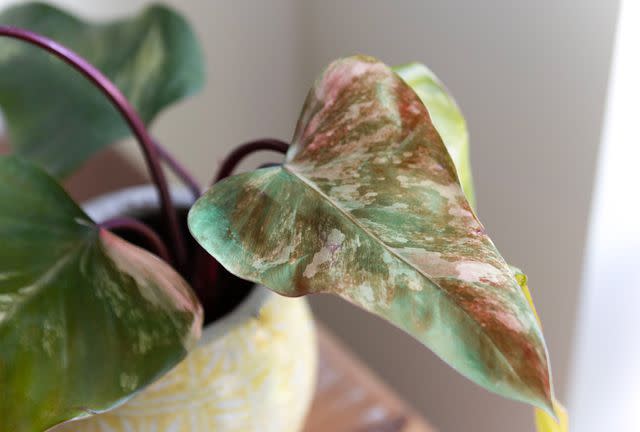
The Spruce / Adelyn Duchala
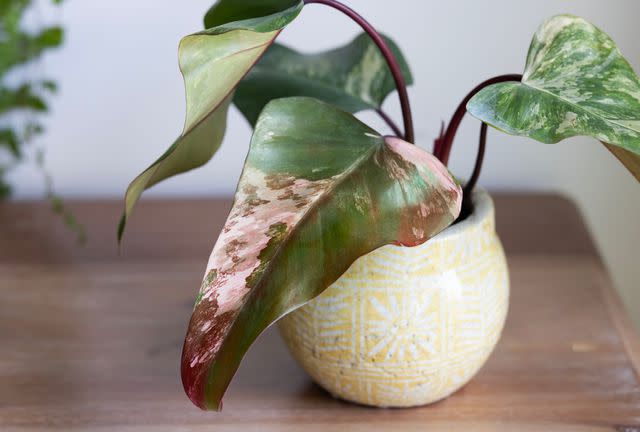
The Spruce / Adelyn Duchala
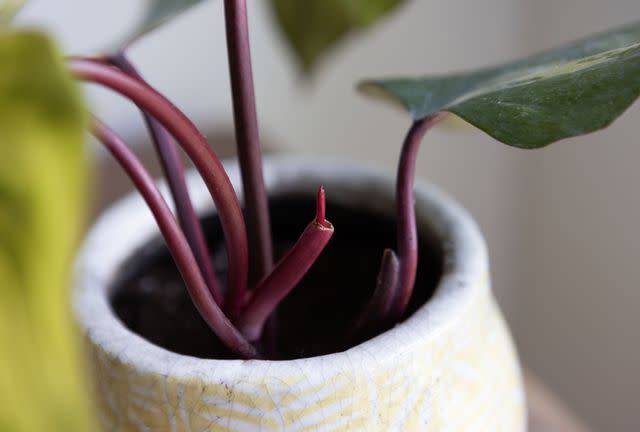
The Spruce / Adelyn Duchala
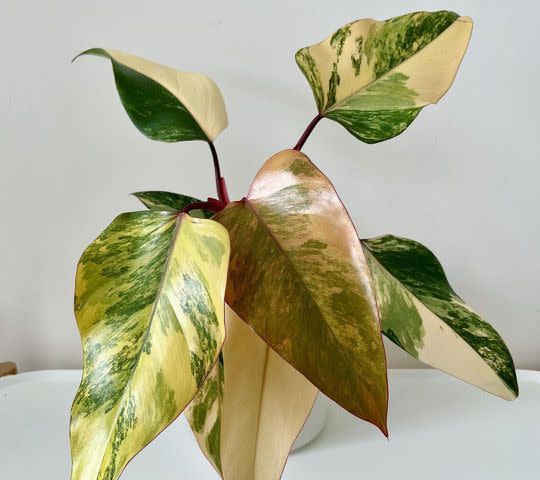
@alexs_greenhouse / Instagram
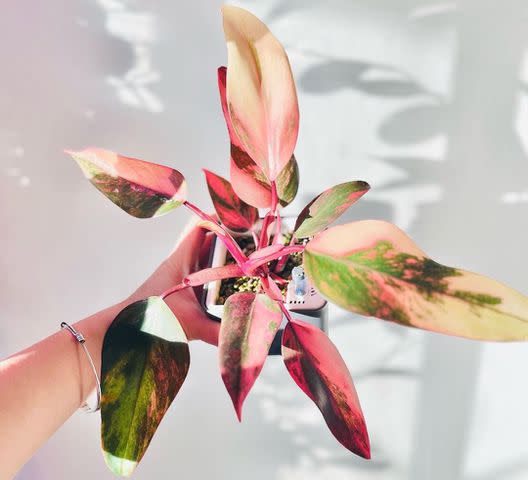
@theunderstories / Instagram
Light
This variegated plant requires plenty of light in order to maintain its color. That being said, its delicate leaves are sensitive to direct sunlight so it should be kept in bright, indirect light at all times. The best place for a strawberry shake philodendron is close to a sunny window but positioned so the sun’s rays never fall directly on its leaves. If it does not receive adequate light, the strawberry shake philodendron may permanently lose its variegation and develop leggy, unattractive growth.
Soil
A soil mix that holds some moisture but is also well-draining is essential for the strawberry shake philodendron. Opt for a soil mix that is specifically formulated for aroids as it is designed to be airy and well-draining. You can also easily make your own aroid soil at home by mixing equal parts indoor potting soil, perlite, and orchid bark.
Water
Keep the soil evenly moist, but never soaking. To prevent overwatering you can allow the top one to two inches of soil to dry out and then water thoroughly. The key is to ensure that you let all of the excess water drain from the pot’s drainage holes before returning the plant to its original location.
Temperature and Humidity
If you have an indoor greenhouse or greenhouse cabinet, the strawberry shake philodendron should definitely go in it. These tropical plants require warm temperatures and high humidity. For the most part, standard household temperature levels are fine, although they will do well with warmer temperatures, particularly when paired with high humidity.
When it comes to humidity, however, most households are too dry for the strawberry shake philodendron to grow happily. Ideally, this plant should grow in humidity levels between 70 to 80%, which can be easily achieved in a greenhouse environment but is difficult to maintain otherwise. But if your house is dry, placing a small plant humidifier close to your plant is a great start, along with growing it in a naturally humid room of your home like the bathroom or laundry room.
Fertilizer
The strawberry shake philodendron is considered a medium to light feeder and only needs to be fertilized once a month in spring and summer. Apply a balanced liquid fertilizer diluted to half strength right after you’ve watered. Stop fertilizing in early fall, as soon as you notice temperatures beginning to drop.
Propagating Strawberry Shake Philodendron
Like other P. erubescens varieties, the strawberry shake philodendron can be propagated by stem cuttings. Here’s how you can propagate a strawberry shake philodendron in just a few simple steps.
Using a pair of sharp pruning shears or scissors, take a stem cutting from a healthy strawberry shake philodendron plant. The cutting should have between three to five nodes, and at least one leaf.
Remove the bottom leaves from the cutting, leaving the top few.
Prepare a glass container with sphagnum moss or water to root the cutting. You can use either medium here with good success; ultimately it depends on your personal preference. If you choose to use sphagnum moss, ensure that you soak the moss beforehand to rehydrate it.
Put the stem cutting in the container, ensuring that the nodes along the bottom of the stem are fully submerged in the water or sphagnum moss.
Place the cutting in a location with bright, indirect light and plenty of humidity. If your home is on the dry side, a clear plastic bag placed over the top of the cutting will help to increase humidity directly around the plant. Just be sure to remove it once a week for 10 to 15 minutes to prevent mold growth.
If you are using sphagnum moss, keep the moss evenly moist at all times. If you are using water, refresh the water once a week. Roots should begin to sprout within a couple of weeks.
Once the roots are at least an inch long the cutting can be planted in soil. Prepare a small pot with a moist but well-draining potting mix, and plant the cutting in the soil.
Water the freshly planted cutting thoroughly, allowing the excess water to drain from the pot, and then return it to a bright location.
Potting and Repotting Strawberry Shake Philodendron
Depending on its growing conditions, a strawberry shake philodendron will likely need to be repotted once every one to two years, or once it has outgrown its previous potting container. Roots growing from the drainage holes and circling the inside of the pot are both signs that your plant is ready for a new container.
Spring and summer are the best months to repot a strawberry shake philodendron since the plant is actively growing and can handle being disturbed more easily. Choose a new pot that is only two to four inches larger than the previous container and then move the plant to its new pot, refreshing as much of the soil as you can during the process. Water the freshly repotted plant thoroughly and then return it to its original location.
Common Pests and Plant Diseases
Strawberry shake philodendrons are susceptible to a few common houseplant pests and diseases. Watch out for signs of pests like mealybugs, scale, fungus gnats, and thrips. If you notice pests on your plant, use a natural or commercial insecticide until the problem is resolved. You can also treat your plant preemptively on a regular basis to try and prevent infestations before they happen.
When it comes to diseases, root rot and fungal leaf spot diseases are the two most important to watch out for. Root rot is usually a result of overwatering, so ensuring that your plant has adequate drainage is important. Fungal leaf spot diseases are common in philodendrons and can be easily passed from plant to plant. Treat infected plants with a fungicide and isolate them from other houseplants until the disease is properly treated. Also, make sure to always inspect your new philodendrons closely before bringing them home to prevent accidentally bringing an infected plant into your home.
Common Problems With Strawberry Shake Philodendron
Variegated plants can be a bit trickier to grow compared to their non-variegated counterparts, and the strawberry shake philodendron is no exception. Here are a few common problems to watch out for.
Losing Variegation
Strawberry shake philodendrons have chimeral variegation which is a type of variegation that is the result of genetic mutations. Unfortunately, this type of variegation is considered unstable, meaning that these philodendrons are susceptible to losing their variegation if they aren’t properly cared for.
Once a variegated plant has reverted it is very unlikely that it’s variegation will return on future growth, but not impossible. The key is to ensure you change the growing environment immediately so that the plant can recover. Usually, reverting is caused by a lack of light, but it is also possible that other factors like low temperatures or a lack of humidity are the problem.
Leaf Spots
Like most philodendrons, the strawberry shake is prone to fungal leaf spot diseases that can quickly affect an entire plant. These spots are small and either brown or orange in color. If you notice that your strawberry shake is developing leaf spot, treat the plant immediately with a fungicidal spray.
Yellow Leaves
Yellow leaves can occur for a number of different reasons. The occasional yellow leaf usually isn’t a big deal—it’s normal for plants to shed old leaves every once and a while. However, if you are noticing that a few of your plant’s leaves are suddenly beginning to turn yellow or new growth is turning yellow, then that’s usually a sign that something in its growing environment is not right. A lack of light, underwatering, overwatering, drastic temperature fluctuations, and a lack of humidity are some of the main causes of yellow leaves. The only way to know for sure what the problem is with your plant is to examine its growing environment closely.
Frequently Asked Questions
How do you make a philodendron strawberry shake pink?
The more light a strawberry shake philodendron receives, the more pink its variegation will be. However, ensure that you keep the plant in bright, indirect light and never expose it to direct sun.
Why is the strawberry shake philodendron rare?
This variegated philodendron is relatively slow-growing and can also be somewhat difficult to care for. It is a naturally occurring hybrid from Ecuador that rarely flowers when grown indoors, so it is mainly manually propagated, which can also take time and is susceptible to error. Plants that are imported from South America also have to take time to acclimatize which can sometimes be unsuccessful. For these reasons, coupled with the high demand, the strawberry shake is rare and difficult to find.
Where can I buy a strawberry shake philodendron?
Most nurseries and garden centers probably won’t carry this rare philodendron. Instead, look online and with local plant collectors and sellers. It’s also worth checking with your local specialty plant stores, who may be able to import one for you.
Read the original article on The Spruce.

